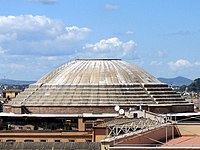
Photo from wikipedia
With respect to the studies conducted so far and lack of researches on the post-heat behavior of cement mortars containing pozzolanic materials, the purpose of this paper is to investigate… Click to show full abstract
With respect to the studies conducted so far and lack of researches on the post-heat behavior of cement mortars containing pozzolanic materials, the purpose of this paper is to investigate the post-heat mechanical characteristics (i.e. compressive, tensile and flexural strength) of cement mortars containing granulated blast-furnace slag (GBFS) and silica fume (SF). In doing so, selected temperatures include 25, 100, 250, 500, 700 and 9000c. Last, the X-ray diffraction test was conducted to study the microstructure of mixtures and subsequently, the results were presented as power-one mathematical relations.,Totally, 378 specimens were built to conduct flexural, compressive and tensile strength tests. Accordingly, these specimens include cubic and prismatic specimens with dimensions of 5 × 5 × 5 cm and 16 × 4 × 4 cm, respectively, to conduct compressive and flexural strength tests together with briquette specimen used for tensile strength test in which cement was replaced by 7, 14 and 21 per cent of SF and GBFS. To study the effect of temperature, the specimens were heated. In this respect, they were heated with a rate of 5°C/min and exposed to temperatures of 25 (ordinary temperature), 100, 250, 500, 700 and 900°C.,On the basis of the results, the most profound effect of using GBFS and SF, respectively, takes place in low (up to 250°C) and high (500°C and greater degrees) temperatures. Quantitatively, the compressive, tensile and flexural strengths were enhanced by 73 and 180 per cent, 45 and 100 per cent, 106 and 112 per cent, respectively, in low and high temperatures. In addition, as the temperature elevates, the particles of specimens containing SF and GBFS shrink less in size compared to the reference specimen.,The specimens were cured according to ASTMC192 after 28 days placement in the water basin. First, in compliance with what has been specified by the mix design, the mortar, including pozzolanic materials and superplasticizer, was prepared and then, the sampling procedure was conducted on cubic specimens with dimension of 5 × 5 × 5 mm for compressive strength test, prismatic specimens with dimensions of 16 × 4 × 4 mm for flexural strength test and last, briquette specimens were provided to conduct tensile strength tests (for each temperature and every test, three specimens were built).
Journal Title: Journal of Structural Fire Engineering
Year Published: 2020
Link to full text (if available)
Share on Social Media: Sign Up to like & get
recommendations!